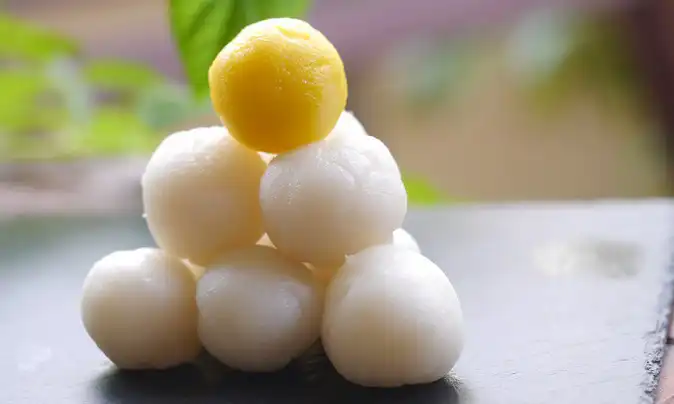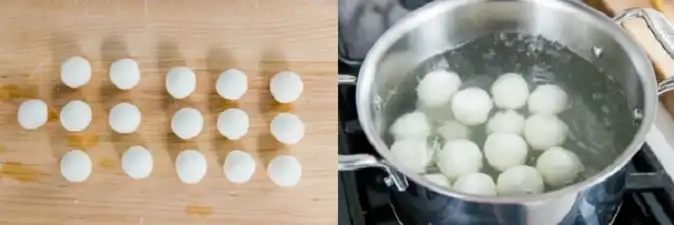Metric:
150ml Water
100gr Dangoko
( Japanese Rice Dumpling Flour )
1 small slice Kabocha Pumpkin
( About 20gr Mashed Kabocha )
Additional Dangoko
( for the Dough )
Recipes > Japanese Recipes > Japanese Dessert Recipes > Japanese Dango Recipes

TRADITIONAL JAPANESE RECIPE: The Japanese love celebrating. With this pyramid arrangement they celebrate the mid-autumn festival. During this time, under a full moon, Japanese people celebrate the harvest and marvel of the passing seasons.
The festival is called Tsukimi (お月見) – Mid-Autumn Festival (Chushu no Meigetsu 中秋の名月) and on this day they display Tsukimi Dango (月見団子)in a special pyramid arrangement.
| Skill Level: |
Time: 60 Minutes |
| Price: |
Makes: 15 Balls |
Ingredients:
| Conversions |
Metric:
150ml Water
100gr Dangoko
( Japanese Rice Dumpling Flour )
1 small slice Kabocha Pumpkin
( About 20gr Mashed Kabocha )
Additional Dangoko
( for the Dough )
Cups:
0.66 cup Water
About 1 cup Dangoko
( Japanese Rice Dumpling Flour )
1 small slice Kabocha Pumpkin
( About 2 teaspoons Mashed Kabocha )
Additional Dangoko
( for the Dough )
Directions:
For the Kabocha:
01 - Bring a big pot of water to boil on low heat and steam the thin slice of Kabocha for about 15 minutes or until ready to be mashed, meaning when a skrewer can go through without resistance.
02 - Trasfer the Kabocha slice to a plate, spoon the inside/flesh and set aside.
To Make Dango:
03 - Put the Dangoko Flour in a large bowl.
04 - Add the Water, slowly, and start mixing. The Dangoko Dough starts to stick together and then it becomes clumps.
05 - At this point, with your hands, put the mixture together into a firm smooth Dough. The texture must be like an earlobe.
06 - Roll the Dough into a ball and divide the Dough into 8 pieces.
07 - Divide each piece into 2 and roll to form 2 balls each. You should now have 16 balls of about 20gr / 0.70oz.
For the 2 Yellow Dango Balls:
08 - Using some extra Dangoko, prepare a small 30gr / 1oz Dango Dough.
09 - Now, mix in the mashed Kabocha prepared in STEP 01 and 02. Combine well until a larger yellow smooth Dough is formed.
10 - Split the Dough into two and form two yellow Dango Balls ( about 20gr / 0.70oz each ).
11 - Boil a large and tall pot of water.
12 - Once the Water in the pot starts boiling, gently drop all the white balls.
13 - Occasionally stir the Water keeping the Dango Balls in motion inside the boiling water so they don't stick on the bottom of the pot.

14 - Once the Dango Balls float on the top, about 2-4 minutes, remove them from the boiling Water and transfer them into Iced Water.
15 - Once the Dango Balls are cooled, drain well and transfer to a tray.
16 - Now, cook the remaining two Yellow Dango Balls and once they start floating, cool them in iced water, drain and transfer on the tray together with the White Dango Balls.
Arranging the Tsukimi Dango Balls:
17 - Place the 15 Dango Balls into a pyramid shape on a plate or tray (or make two smaller pyramids). The larger pyramid should be 9 Balls on the bottom, 4 in the middle, and the 2 Yellow Balls right on top.
Topping:
18 - After displaying Tsukimi Dango for hours or a day, the dumplings will become hard to eat. At this point you can cut and/or toast the balls in the oven or a frying pan.
19 - Once cooked, coat the Dango Balls with Sweet Soy Glaze.
Notes:
- STEP 09: depending on the Kabocha and the way it is cooked, it may contain more or less moisture. If it's too wet just mix some extra Dangoko to make it firmer.
- STEP 10: if the Dough cracks or wrinkles form, tap your finger in water and apply a small amount of water on the cracked area to smooth out.
- STEP 15: wet the tray so the dumplings won’t stick.
- Place the Dango Balls on a tray and you can freeze them for 1 month. When you want to use them, microwave or boil them till they are warm and soft.
- To keep the Dango tender for a longer time add some Sugar to the Dango Dough. This should be enough to keep them softer for longer. The recommended amount of Sugar needed is 1/5 of Flour-weight.
| Written by: Uncut Recipes | Disclaimer |

| YOU MIGHT ALSO LIKE: |
| LATEST RECIPES: |
Beth
November 06, 2019 I love tsukimi dango because you can use them as normal dango and top them with whatever you want. |

November 13, 2019
Interesting recipe! Thanks for sharing!